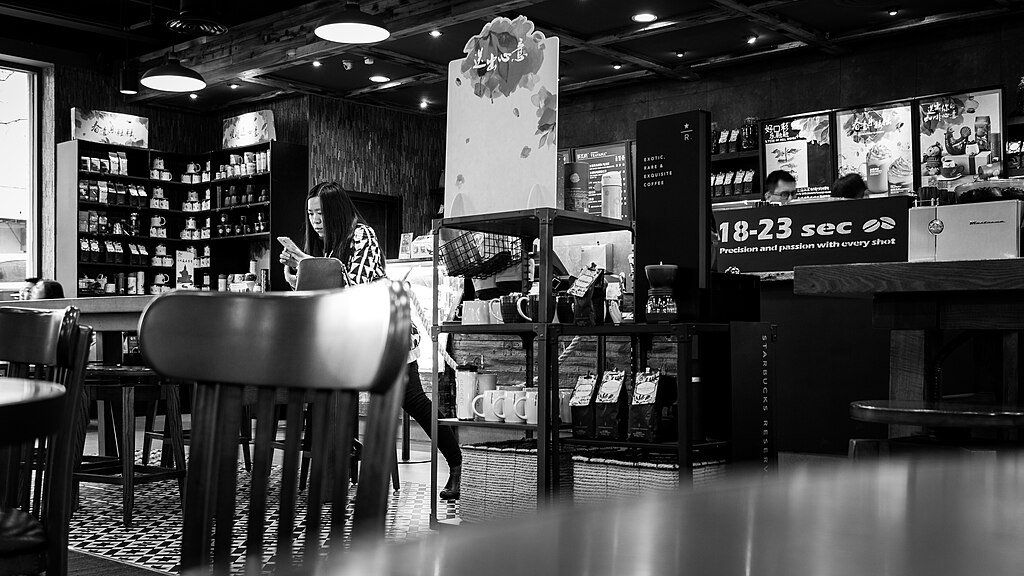Media coverage
 Behind sensational headlines and viral videos lies an economy profiting off misinformation — leaving fact checkers feeling outmatched.
Behind sensational headlines and viral videos lies an economy profiting off misinformation — leaving fact checkers feeling outmatched.
Published August 24, 2025
 Ava Hu
Ava Hu

Woman scrolls on phone in Qingdao, China (Photo by Gauthier DELECROIX - 郭天 from Qingdao, China is licensed under CC BY 2.0.)
Late at night, after putting their child to bed, “Moreless” switched their keyboard language to Mandarin and began another round of digital detective work.
Tonight’s keyword: “拒绝国王” (“No Kings”), a reference to a day of nationwide protests against President Donald Trump on June 14, 2025. Earlier in the day, Moreless had screenshotted a few suspicious posts on X from accounts that appeared to be Chinese “current affairs” influencers — one suggesting a Walmart heiress was funding the protests, another pointing fingers at a billionaire in Shanghai. Now, they were digging deeper.
This is Moreless’ fifth year as a freelance fact-checker. They asked to use a pseudonym due to concerns about retaliation. “Moreless” is the name of their Chinese-language fact-check blog, which has garnered over 2,500 followers. By day, they work as a cybersecurity engineer, seldom talking politics with coworkers. Few colleagues know that at night, Moreless tracks viral misinformation across platforms.
The Walmart heiress rumor they had seen earlier was already gaining traction on Chinese-language platforms. Through searches, Moreless traced its origin to several apparently U.S.-based X accounts active in political commentary, which had posted images of an advertisement in The New York Times promoting the “No Kings” protest. At the bottom, the ad read, “Paid for by Christy Walton,” the daughter-in-law of Walmart founder Sam Walton.
The image was translated into Chinese and reposted by Chinese political commentary accounts on X. As it circulated, the content drifted further out of context. One article on WeChat claimed, “Walmart heiress behind America’s largest protest.” In the public group chats that Moreless follows, some were already calling the protesters “paid American actors.”
This kind of misinformation flow has become increasingly well oiled since the start of the 2024 U.S. presidential election season, creating a pipeline between English- and Chinese-language audiences in the U.S.
Moreless remembers writing their first fact-checking article. It was during the George Floyd protests in 2020, when many Americans took to the streets to speak out against racism and police brutality. But in Chinese-language spaces, another narrative was unfolding: viral videos of footage, real but distorted through misleading captions and selective editing, showing scenes of white people kneeling to Black Americans, licking their shoes and washing their feet.
One of the most widely circulated videos came from the People’s Daily’s Douyin channel, the Chinese version of TikTok owned by TikTok parent ByteDance. People’s Daily, the official newspaper of the Chinese Communist Party, did not cite a source for the footage, but echoed claims circulating on X that white police officers were washing the feet of a Black pastor in the video. Forbes fact-checked the claim and found it to be false; in the footage, the officers were kneeling to support the movement against police brutality, not washing feet.
The video received around 1,000 likes and was also reposted by the Douyin channels of media outlets Guancha, China Net and Eastday, with total views estimated to be in the tens of thousands. “That was when I realized how far these stories could go,” Moreless said.
Over the past decade, many Chinese media outlets have pivoted to short-form videos. A former producer at a state-owned news outlet, speaking anonymously out of fear of retaliation, explained that video platforms offer faster profits than traditional print or online publication ads. At legacy outlets like theirs, credibility made posting news-style advertisements especially profitable, allowing them to charge higher rates. Posting a single video could fetch more than the producer’s monthly salary, they said.
To generate content, the producer often scoured sites like the New York Post and The Sun for provocative tidbits, from lifestyle stories such as “Diabetes cases among Americans are surging” to political curiosities like “Biden bitten by his dog.” Much of this content, they acknowledged, was selected for its click appeal.
The producer would then repackage the stories into short-form videos using CapCut, a video-editing app owned by ByteDance. The outlet’s editing template would already be set up, with on-screen titles in three fixed styles: white letters with a black border for emotional punch, black letters on a yellow background for the core message and white letters outlined in red for gossipy details.
If the footage lacked impact, they added stickers and sound effects. If there was a gap, they dropped in a screenshot of a “netizen’s hot comment,” framed in yellow with the label “for reference only.” Sad stories got somber background music from the app’s library, “shocking” news was paired with dramatic “dun-dun-dun” sound effects and upbeat stories got a gentle piano track.
The producer repeated this process dozens of times a day, they said, each clip taking no more than 20 minutes to edit from start to finish.
The goal was reach, chasing clicks and views. Each producer was required to publish at least 20 videos per day on the outlet’s video channels. Editors might check if a video landed well with the audience, the producer said, but rarely questioned its content.
“You don’t care about the Five Ws,” they said, referencing journalism’s fundamental questions (who, what, when, where, why). “You just need something sensational.”
Jinxia Niu, a digital platform manager at Chinese Affirmative Action, a San Francisco-based nonprofit that advocates for democracy in the Asian American and Pacific Islander community, said social media’s “most fundamental original sin lies in the fact that it doesn’t care whether the information is true or not.” Even factual stories often become distorted in the video production process, Niu said, as they’re paired with dramatic music and visuals to provoke emotion.
Moreless has felt the futility of fighting falsehoods on social media. The more detailed their fact checks became, the less attention they seemed to get. “People say California is about to force unisex bathrooms,” they said. “I could walk them through every law and explain the myth, but next time someone shares it in a chat, they’ll still believe it. The phrase ‘unisex bathrooms (男女同厕)’ is just too catchy.”
Curating and reposting news isn’t limited to short-form video apps. A 2020 Hoover Institution study found that the most visited Chinese-language sites among the Chinese diaspora that year were news aggregators like Wenxuecity and BackChina that mostly repost content from public WeChat accounts.
One editor at a Chinese-language news aggregator site, who asked to remain anonymous, said their job was to copy, paste and rewrite headlines to make them more click-worthy. When they first joined the site, they tried posting some fact checks, like a public health explainer debunking rumors, widely shared on platforms like X by political influencers, that COVID-19 vaccines contained government microchips. But the comments section was brutal. “People said, this is just what the government wants us to believe,” they recalled. “They accused me of [being biased].”
There were also times when the editor in chief removed their posts because they didn’t generate enough traffic. “He told me not to post things readers wouldn’t understand,” the editor said. Each day, they were required to publish 50 stories, each expected to reach about 15,000 views. The target wasn’t hard to hit, but it meant tailoring content to what readers wanted.
“You have to use words that hit hard, even if they’re out of context,” the editor said. “Or stir up conflict — make people want to click just so they can get angry in the comments.”
The editor said most of the site’s content came from public WeChat accounts, where commercial interests shaped what appeared as news. In the international news space, articles that top 100,000 views under topics like “presidential election” or “Los Angeles wildfire” often come from private businesses. At the bottom of these seemingly hard-news stories, there are usually telltale ads for the organizations behind the accounts: “It’s too late to start test prep in high school,” “Scan QR code for your free materials pack!” or “Exclusive college admissions class, limited spots for parents!”
Zhicheng Chang, who runs a current affairs WeChat account to promote his SAT test prep company, put it bluntly: “Most families in China barely understand the U.S. … You use that gap. Hook them, make them anxious, then they’ll pay you.” Although his account targets parents in China, much of its content ends up circulating among Chinese-language audiences overseas.
Chat logs provided by Chang show he urged writers to use copy-paste tactics freely, as long as posts pass the platform’s plagiarism check. In December 2024, when several U.S. universities warned international students about traveling abroad ahead of Trump’s inauguration, Chang instructed his team to rework a story and titled it, “Trump to ban Chinese students from entering U.S.”
The article they drew from was published by another overseas education account, which ended with a promotion reading, “Join our study-abroad WeChat group by scanning the QR code for expert tips and resources.” The piece referenced an email from Cornell University’s Office of Global Learning recommending that all international students avoid traveling during the winter break due to a potential travel ban.
Chang’s article did not change many details; it was essentially a replica of the original piece with a more definitive headline. His company’s post racked up over 10,000 views within a day. Similar headlines soon appeared on BackChina and Wenxuecity.
While many mainstream U.S. news outlets have invested in fact-checking, those efforts rarely reach non-English platforms, leaving gaps that Chinese-language fact-checkers struggle to fill.
Rumors take on different forms on Chinese platforms than on English ones, often playing on biases within Chinese American communities, such as resentment toward other racial groups, in ways that outsiders may struggle to recognize or address. “These political rumors in Chinese, especially those targeting the Black community and women, like Kamala Harris, can’t get any support from mainstream media,” Niu said, adding that there is a lack of context and clarification provided by Chinese media outlets. “You need language, cultural and digital competence all at once to address them, and that’s rare.”
For a group like Chinese Affirmative Action, every day feels “like dropping a needle into the sea,” Niu said.
As one of the group’s volunteer fact-checkers, Moreless felt the same way, especially around the 2024 election. But the frustration rarely lingered. Three days after the election, they published a new fact check titled, “Did Harris receive 15 Million less votes than Biden in 2020? False,” debunking a claim circulating on X. It received three likes.
“At least it makes me feel like I’m not just sitting behind a screen, watching all of this happen,” they said.
Note: Interviews for this story were conducted in Mandarin. Quotations were translated into English and verified with the speakers for accuracy.

University of California, Berkeley
Media coverage
Seattle 2025





Apply
Become a fellow or editor
Donate
Support our impact
Partner
Work with us as a brand

The Asian American Journalists Association (AAJA) is a membership nonprofit advancing diversity in newsrooms and ensuring fair and accurate coverage of communities of color. AAJA has more than 1,500 members across the United States and Asia.